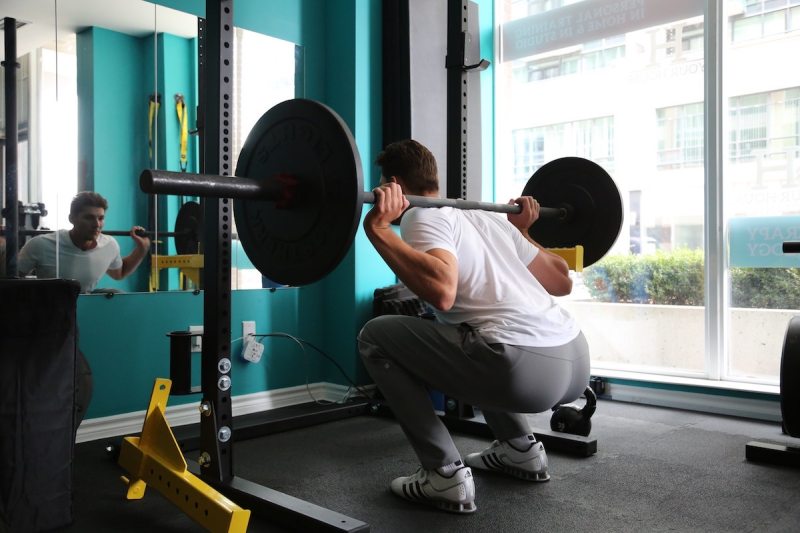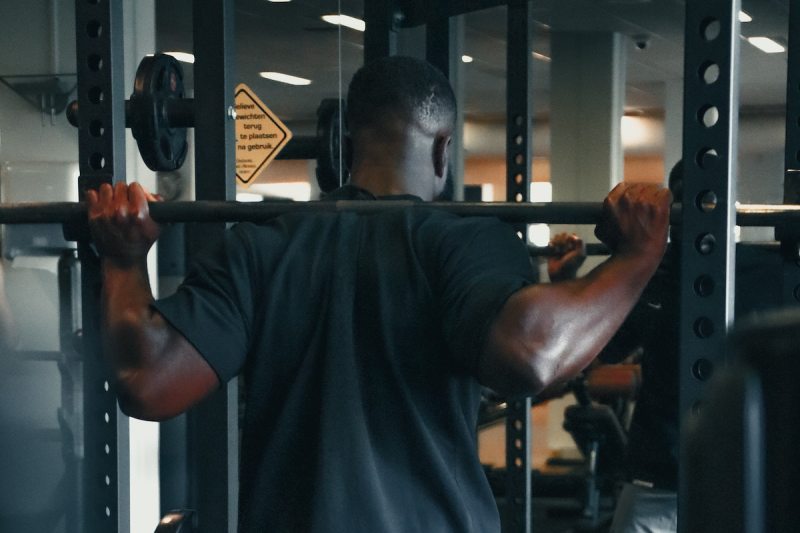Front squat vs. back squat — fitness enthusiasts sometimes debate the relative merits of these two exercises. Both moves are fundamental in strength training routines and offer unique benefits, so understanding the differences between these two squats can help you decide which one is better suited for your fitness goals. Of course, there’s nothing wrong with doing both!
In this article, we’ll explore the muscle groups targeted by each squat, provide step-by-step instructions on how to perform them, and discuss which might be the best addition to your workout routine. You’ll have all the information you need to make a decision or to do both exercises fluidly. Let’s get started!
Do front squats and back squats work different muscles?

Yes, front squats and back squats do target different muscle groups, although there is some overlap. Front squats target the quadriceps, core, and upper back muscles. Holding the barbell in front also requires more core stabilization and places greater emphasis on the quads.
On the other hand, back squats are more effective at targeting the glutes, hamstrings, and lower back. The barbell’s position on the upper back allows for a greater range of motion in the hips, making it a powerful exercise for overall lower body development.
One study compared front and back squats and found that they activated different muscles and had different injury risks. Front squats were more stable and less likely to cause injury. If you’re worried about injury, this might be a good reason to prefer front squats.
How to perform the front squat

Instructions:
- Stand with your feet shoulder-width apart.
- Place the barbell across the front of your shoulders, resting it on your deltoids.
- Cross your arms over the barbell, keeping your elbows high.
- Engage your core and keep your chest up.
- Lower your body by bending your knees and hips, keeping your back straight.
- Descend until your thighs are parallel to the ground.
- Push through your heels to return to the starting position.
Recommended sets and reps: 3 to 4 sets of 8 to 12 reps
How to perform the back squat

Instructions:
- Stand with your feet hip-width apart.
- Position the barbell on your upper back, just below the neck.
- Grip the barbell with your hands slightly wider than shoulder width.
- Engage your core and keep your chest up.
- Lower your body by bending your knees and hips, keeping your back straight.
- Descend until your thighs are parallel to the ground.
- Push through your heels to return to the starting position.
Recommended sets and reps: 3 to 4 sets of 8 to 12 reps
Determining which belongs in your routine

If your primary aim is to build stronger quads and improve core stability, front squats might be the better choice. They are also beneficial for improving posture and reducing the risk of lower back injuries, and they have a slightly lower injury risk overall. On the other hand, back squats are highly effective if you’re looking to develop overall lower body strength, particularly in the glutes and hamstrings. They allow for heavier lifting and greater muscle activation in the posterior chain.
Using both variations might provide the most balanced approach to lower body training. Since the muscles targeted do overlap, you should probably do them on different days to avoid overtraining and exhaustion. Both variations provide a variety of benefits for your workout routine and your fitness goals, so you can choose either or both, whatever works best for your needs.
Common mistakes made when doing squats

Front squat
One common mistake in front squats is allowing the elbows to drop, which can cause the barbell to roll forward and disrupt your balance. This often happens when the lifter’s upper back and core are not engaged properly.
Another frequent error is leaning too far forward, which places undue strain on the lower back and reduces the effectiveness of the exercise. Additionally, failing to maintain an upright torso can compromise form and lead to potential injuries. It’s crucial to keep the core tight and the chest up throughout the movement to ensure proper alignment and muscle engagement.
Back squat
A typical mistake in back squats is positioning the barbell too high on the neck, which can cause discomfort and even injury. Lifters also often allow their knees to cave inward during the descent, leading to knee pain and instability.
Another issue is not squatting deep enough, which limits muscle activation and the overall benefits of the exercise. Ensuring that the thighs reach at least parallel to the ground is essential for maximizing muscle engagement. Maintaining a strong core and a neutral spine throughout the movement also helps prevent lower back strain and promotes better form.
Squat alternatives to try
Smith machine squats

Instructions:
- Position yourself under the bar of the Smith machine.
- Place the bar across your upper back.
- Stand with your feet shoulder-width apart.
- Lower your body by bending your knees and hips.
- Push through your heels to return to the starting position.
Recommended sets and reps: 3 to 4 sets of 10 to 15 reps
Goblet squats

Instructions:
- Hold a dumbbell or kettlebell close to your chest.
- Stand with your feet shoulder-width apart.
- Lower your body by bending your knees and hips.
- Push through your heels to return to the starting position.
Recommended sets and reps: 3 to 4 sets of 10 to 15 reps
Hack squats

Instructions:
- Place your shoulders under the pads and your feet on the platform to position yourself on the hack squat machine.
- Lower your body by bending your knees and hips.
- Push through your heels to return to the starting position.
Recommended sets and reps: 3 to 4 sets of 10 to 15 reps
Frequently asked questions

Should you add weight to squats?
Yes, adding weight to squats can help increase muscle strength and hypertrophy. However, with weighted squats, it’s even more important to use proper form and increase your squat weight gradually and carefully. Adding weight to squats significantly increases your chances of injury.
Do front squats build big legs?
Front squats can contribute to building bigger legs, particularly by targeting the quadriceps. Back squats are also good for building your legs, especially since you can usually use heavier weights for back squats.
Why is my front squat deeper than my back squat?
Front squats are usually deeper because your torso is upright, reducing the strain on the lower back and allowing for greater knee flexion. Changing small elements of your position can make a huge difference to how you perform a squat, so pay attention to your body.




